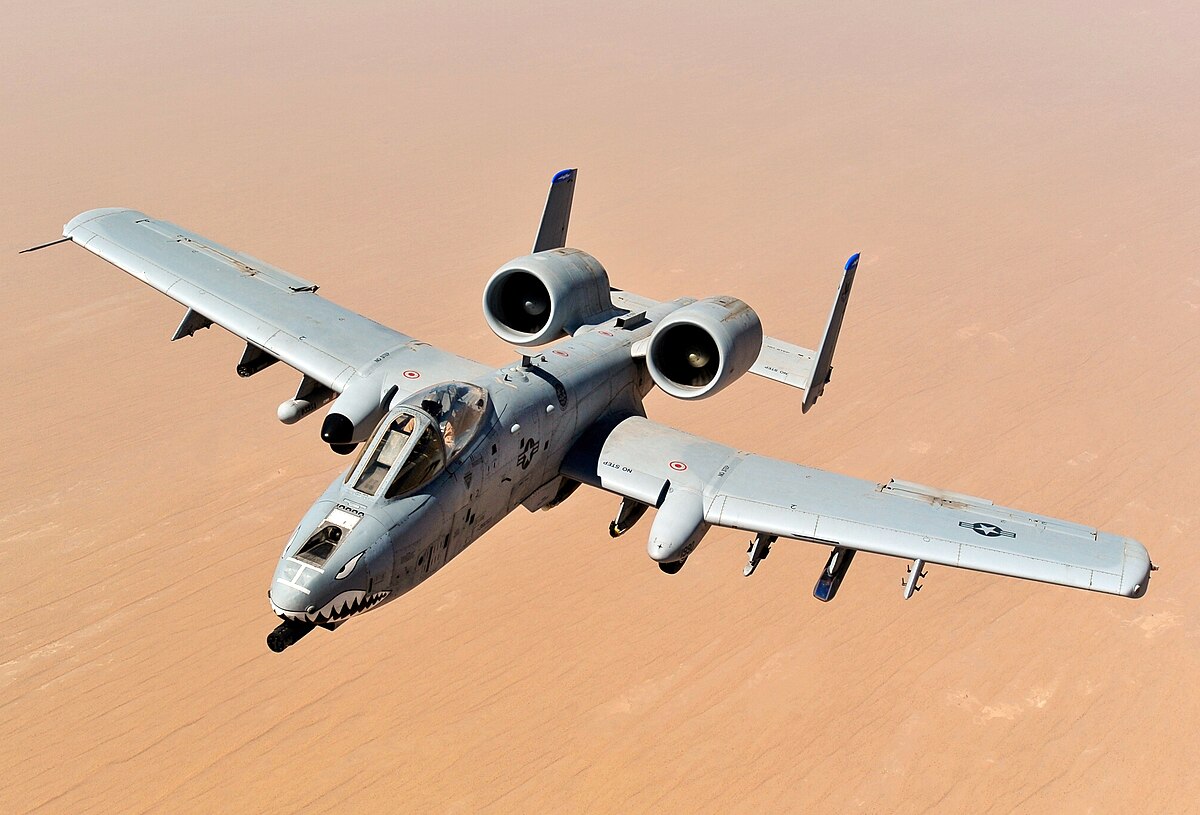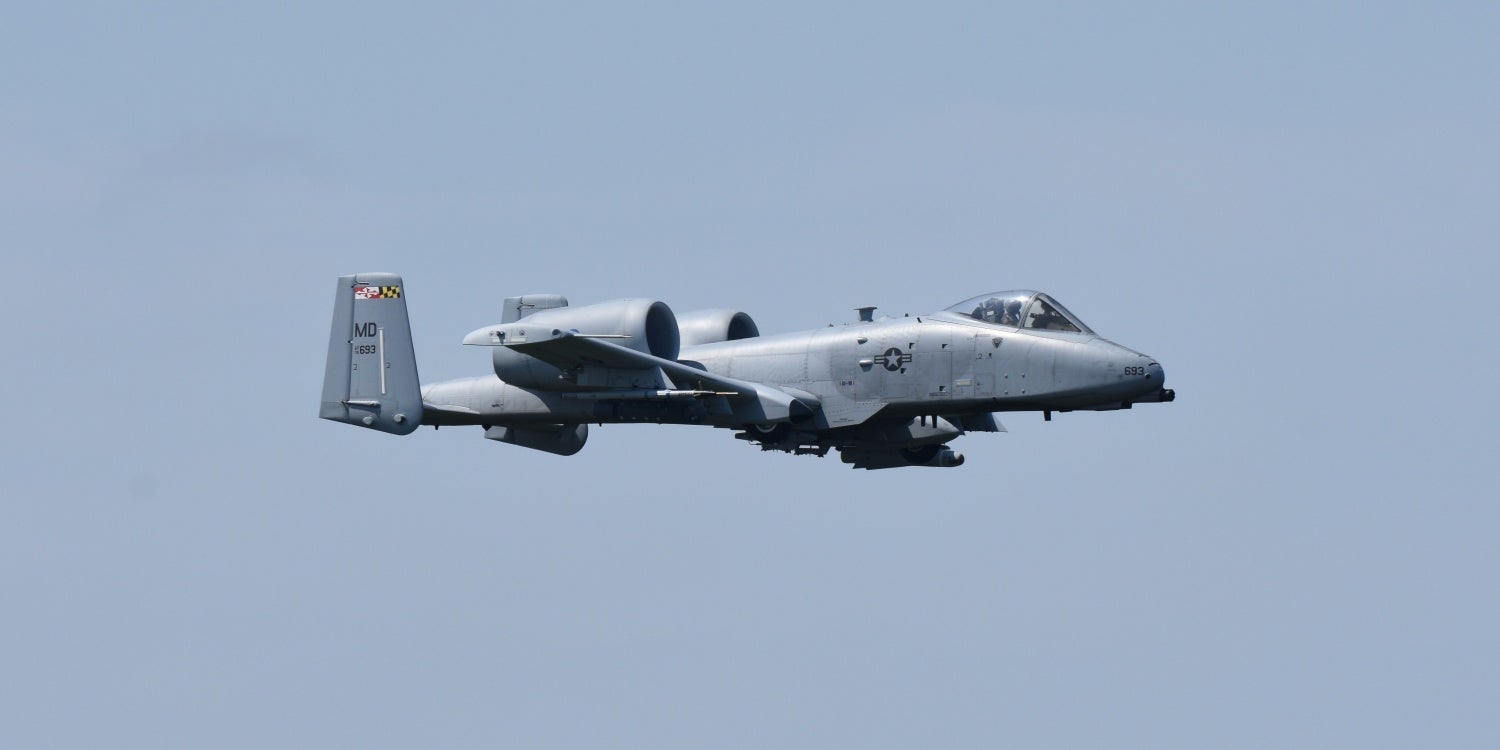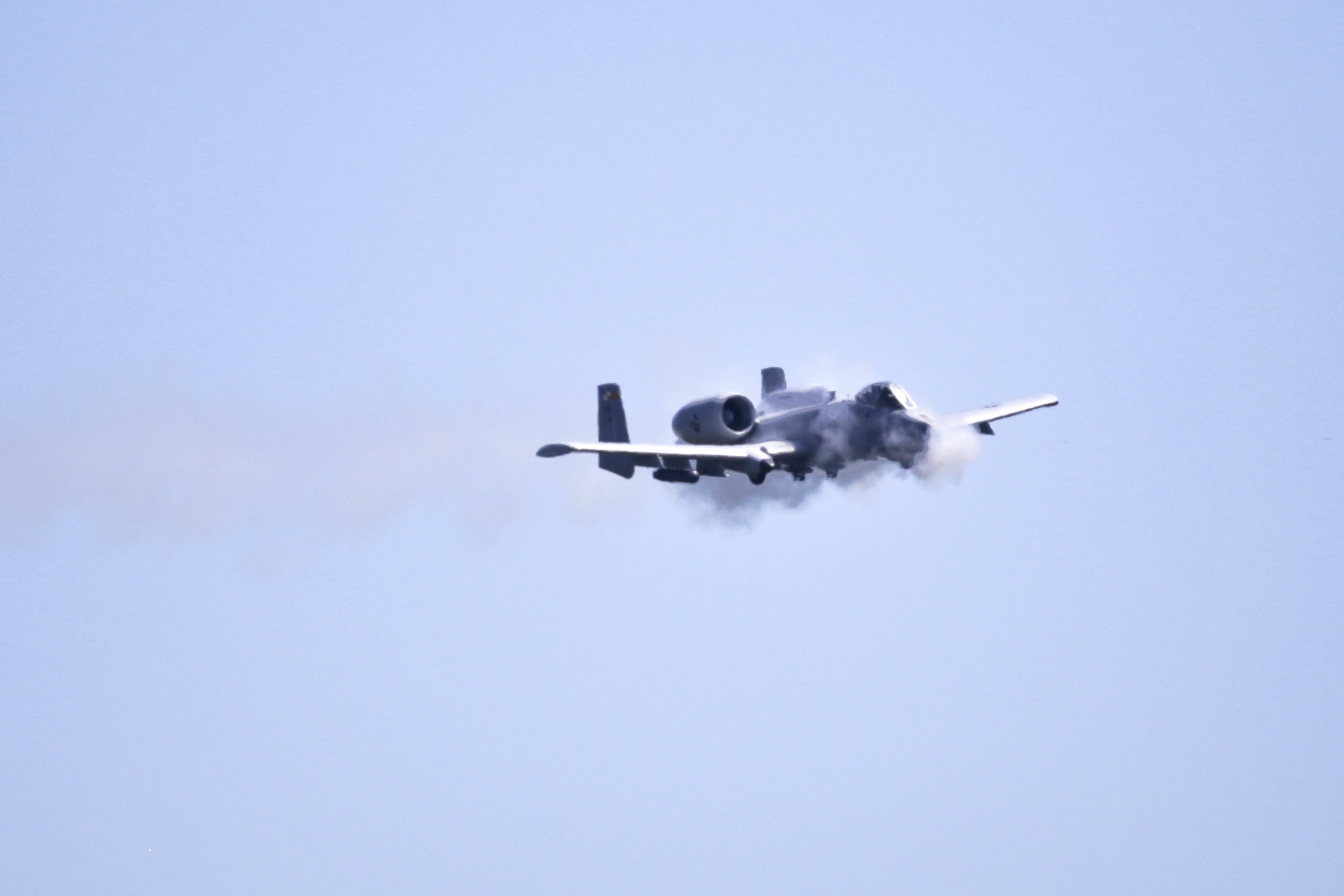A10 Strafing Run - The size of this preview is 800 × 521 pixels. Other resolution: 320 x 209 pixels | 640 x 417 pixels | 1024 x 667 pixels | 1, 280 x 834 pixels | 3008 × 1960 pixels.
United States An Air Force A/OA-10 Thunderbolt II of the 355th Fighter Squadron is surrounded by a cloud of smoke while firing the GAU-8 Avenger Gatling 30mm gun at the Pacific Alaska Range Complex, Alaska, May 29, 2007 - Gatling barrel can fire at a rate of 3900 rounds per minute. DoD photo: Airman 1st Class Jonathan Snyder, US Air Force.
A10 Strafing Run
This image or file was created by a U.S. Air Force Aviator or an employee employed or employed as part of that person's job duties. As a work of the United States federal government, the image or file is in the public domain in the United States.
File:a 10 Thunderbolt Ii Gun Run.jpeg
{{Information |Description=United States An Air Force A/OA-10 Thunderbolt II of the 355th Fighter Squadron is surrounded by a cloud of smoke while firing its GAU-8 Avenger Gatling 30mm gun at Pacific Alaska Range Complex, Alaska, May 29, 2007 .
This file contains additional information such as Exif metadata that may have been added by the digital camera, scanner, or program used to create or digitize it. If the file has been modified from its original state, some details, such as the timestamp, may not fully reflect the original file. The timestamp is as accurate as the camera clock and can be completely wrong.
United States An Air Force A/OA-10 Thunderbolt II of the 355th Fighter Squadron is surrounded by a cloud of smoke while firing the GAU-8 Avenger Gatling 30mm gun at the Pacific Alaska Range Complex, Alaska, May 29, 2007 - Gatling barrel can fire at a rate of 3900 rounds per minute. DoD photo: Airman 1st Class Jonathan Snyder, US Air Force. (Issued) Less commonly, the term is used as an extension to describe rapid fire on any warship or warship, such as fast boats, using smaller caliber weapons and aiming at stationary or slow-moving targets.
The word is an adaptation of the German straf to punish, in particular from a humorous adaptation of the German anti-British slogan Gott strafe gland (May God punish the gland), dating from World War I.
Why Russia And China Would Slaughter The A 10 Warthog In A War
Guns used at firing ranges ranging in caliber from 7.62-14.5 mm (0.300-0.571 in) machine guns to 20-40 mm (0.79-1.57 in) autocannons or rotary cannons. Although a ground attack with automatic weapons is often accompanied by bombing or rocket barrages, the term "strafing" does not specifically include the latter two.
The term "barrage" can include both fixed and flexible weapons. Fixed guns that fire directly forward td to be more dominant over fixed wing aircraft while td helicopters use gimbal guns which can fire in many different directions regardless of which direction the plane is pointing (flexible guns on fixed wing aircraft in most cases they are for defensive purposes only, although they can sometimes be used to fire at ground targets with limited effect).
Some fixed-wing aircraft, such as fighter-bombers, can perform both air and ground missions (P-47 Thunderbolt), while others are designed for ground attack (Il-2 Sturmovik). In cases where the aircraft is capable of both types of combat, where it is assigned a ground attack role and thus expected to use guns for strafing, fixed weapons are often mounted so that the convergence point is lower and has a wider range than would be used for air combat. This is helpful as it allows the pilot to aim at the target without having to dive sharply towards the ground, reducing the risk of hitting the ground and increasing the amount of firing time available before needing to pull up, and extending that time away from the target, helping to avoid anti-aircraft fire and potential damage caused by exploding targets.

Due to the low altitude and relatively low flight speed required for accurate fire, it is extremely dangerous for the pilot, who is exposed not only to the danger of falling into the terrain and obstacles such as power lines, but also to anti-aircraft weapons. , including surface-to-air missiles (both vehicle-mounted and hand-held), anti-aircraft artillery and small caliber weapons (such as machine guns and small arms). Aircraft specifically designed for ground attack may incorporate additional armor around and below the cockpit and other vulnerable areas such as gins to protect the pilot and key flight components, while aircraft are designed for air combat to have most of the armor placed directly in front. or to the rear, where fire from other aircraft is likely, facilitating them to burn directly from below, or from the sides, where fire is often from the ground.
This Video Shows Why The A 10 Warthog Is Still A Great Attack Aircraft
While the earliest use of military aircraft was for observation and artillery control, strafing was practiced frequently during World War I. Trenches and supply columns were regularly attacked from the air during the second half of the war. Machine gun fire was used when accuracy was required (when faced with small targets), but non-barreled attack methods (primarily small bombs) were preferred for larger targets, target area, or if flying at low altitude was too dangerous.
The German Army was the first to introduce a class of aircraft specifically designed for strafing, the attack aircraft. Aircraft designed specifically for strafing included the World War I German Junkers J.I, which was armored to protect it from ground fire. Junkers J.I. two downward-pointing machine guns were used for strafing.
This development continued into World War II with dedicated aircraft, including the concept of a heavily protected cockpit or "tub" to allow the pilot to survive anti-aircraft fire from anti-aircraft batteries.
The best ground attack aircraft of the Luftwaffe was the Junkers Ju 87 Stuka. The Ju 87 G variant had two Rheinmetall-Borsig 37 mm (1.5 in) Flak 18 guns each mounted under the wing.
You're Dead: Watch The A 10 Warthog Absolutely Decimate A Humvee
For the RAF, the best attack aircraft was the Hawker Hurricane II. It was armed with four 20 mm (0.79 in) cannons mounted on the wings.
The Hawker Typhoon was used in the later stages of the war. It has four RP-3 "60 lb" rockets.
For the USA Republic, the P-47 Thunderbolt is one of the main attack aircraft. It is armed with eight .50 caliber (12.7 mm) machine guns. Another major aircraft in this role is the North American B-25 Mitchell. It was used for low-altitude strafing during the Pacific War.

The Russian Ilyushin Il-2 Sturmovik is one of the main Russian attack aircraft. It has heavy armor around the gin, underside and canopy. Depending on the model, it was armed with a 20, 23 or 37 mm (0.79, 0.91 or 1.46 in) gun.
The Explosive Rise In A 10 Warthog Strikes, Visualized
An RCAF Spitfire of 412 Squadron piloted by Charley Fox rammed Erwin Rommel's command car on 17 July 1944 near Sainte-Foy-de-Montgommery, affecting its eventual involvement in Operation Valkyrie's coup d'état on 20 July 1944.
During the Korean War (1950–1953), U.S. Air Force aircraft strafed targets behind the front lines and had a significant impact on the development of land warfare, but the strafing concept had already collapsed.
By the 1960s precision-guided weapons had become commonplace, gunfire had temporarily fallen out of favor as unnecessarily risky, and some American fighter or attack aircraft (such as the F-4 Phantom and A-6 Intruder) had no built-in . cannon or machine gun. During the Vietnam War, this was considered a disadvantage and improvised "battleships" had to be used in strafing missions. Battleships such as the AC-47 Spooky, AC-119 Specter, and earlier models of the AC-130 Spooky have proven to be devastating defenders of besieged U.S. Special Forces camps.
The A-10 Thunderbolt II is an American twin-engine straight-wing jet aircraft developed by Fairchild-Republic in the early 1970s, which is the only US Air Force aircraft designed exclusively for close air support of ground forces. The A-10 was built to engage tanks, armored vehicles, and other ground targets with limited air defenses, often by strafing.
Why The A 10 Is Just Not The Right Jet For Ukraine
The A-10 was designed around the GAU-8 Avger, a 30 mm (1.2 in) rotary gun that was the aircraft's main armament and the heaviest autocannon mounted on an aircraft. The A-10's airframe was designed for survivability, with dimensions such as 1,200 lb (540 kg) of armor to protect the cockpit and the aircraft's systems that allow the aircraft to continue flying after heavy damage. The official name of the A-10 comes from the World War II Republic P-47 Thunderbolt, a fighter that was particularly effective in close air support. The A-10 is the basic American aircraft designed to conduct fire.
Since 2001, coalition pilots in Iraq and Afghanistan have been conducting strafing operations to support ground forces in areas where explosive ordnance could cause unacceptable civilian casualties. Firing F-16s are extremely dangerous for the pilot. The cities of Damascus and Aleppo were shelled by attack helicopters during the Syrian civil war.
In 2004, the United States Air Force accidentally shelled one of its country's middle schools during Little's Exercise.

A10 strafing run afghanistan, a10 warthog strafing run, strafing run, a10 envelopes, a10 gpu, a10 gun run ringtone, a10 com temple run, 1746 a10, strafing, a 10 warthog strafing run, nvidia a10, strafing run ww2
0 Comments